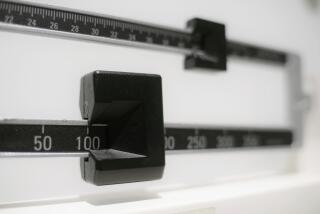Jolt of Reality Jump-Starts His Low-Fat Diet
- Share via
In late summer of 1995, I extricated my Exercycle from beneath a pile of clothes and dust in the garage and started riding three days a week. I worked more salads into my diet and started cutting down on the beer and snacks, but I didn’t really start a serious low-fat diet. At the time, I weighed 350 pounds and had a 54-inch waist. My cholesterol level was 158.
On Oct. 31 of that year, I went to the emergency room with a back pain that was diagnosed as a muscle spasm. An EKG showed I had atrial fibrilation (an irregular heartbeat) unrelated to the back pain. Medication did not correct the problem, so in January, my cardiologist prescribed a blood thinner and, after four weeks, an attempt was made to correct the atrial fibrilation using electric shock with paddles--just like on “ER.”
It was during this waiting period that I started a low-calorie, low-fat regimen.
For breakfast I have a whole grapefruit and a bowl of high-fiber cereal with low-fat milk. Lunch consists of low-fat cottage cheese. Dinner is usually a frozen low-calorie, low-fat meal, many of which I have found to be quite tasty. Several nights a week, I do eat a “regular” meal (pasta, steak occasionally or whatever else my wife might decide to prepare) without worrying too much about the calories. I eat many servings of fruit every day, and for after-dinner sweets, I choose low-fat or nonfat cookies. I also consume copious quantities of water.
When the attempt to correct my atrial fibrilation with paddles was unsuccessful, my doctor suggested I take a stress/echo test. I was so out of shape, I couldn’t complete the treadmill portion of the test and lay gasping as they completed the echocardiogram.
An angiogram a week later confirmed I had an artery sufficiently clogged to require angioplasty, performed the following week.
The first week of April 1996, I started a 12-week cardiac rehabilitation program, using treadmill, stationary bike and weights, at West Hills Hospital, where the wonderful staff actually made the rehab program enjoyable.
When the rehab ended, I continued to exercise at my company fitness center. I do 20 minutes on the treadmill and 25 in the weight room three days a week.
By January of 1997 my cholesterol level was 116 and my weight was 253 pounds. In August, I had another stress test, which I passed with little effort. Currently, I weigh 240 pounds and have a 42-inch waist.
In addition to feeling healthier, other benefits have derived from my weight loss like being able to sit in an airplane seat without stretching the seat belt to its limit or sliding into a restaurant booth without having the waitress ask, “Will you be all right there, or would you prefer to be seated at a table?”
My daughter, a dietitian, is proud that I was able to lose weight and lower my cholesterol. She cites me as an example to her patients.
(BEGIN TEXT OF INFOBOX / INFOGRAPHIC)
Vital Statistics
Name: Robert E. Wilson
Age: 66
Occupation: Retired aerospace project manager
Old weight: 350
New weight: 240
Time to get there: 18 months
Want to Share Your Success Story?
Losing weight is as individual as gaining weight. Do you have a story on how you got in shape and stayed there? If so, we’d like to hear from you with a 500-word essay listing what worked in terms of diet, exercise, encouragement / support, as well as your emotional and physical changes.
We’d also like you to send us full-body color photos of you, before and after.
Send essay and photos to “How I Did It,” Health, Los Angeles Times, Times Mirror Square, Los Angeles, CA 90053, and include daytime and evening phone numbers. No phone calls, please. Submissions cannot be returned.
In addition to publication, winners will receive a Los Angeles Times gym bag and a gift certificate for a free pair of athletic shoes of your choice, redeemable at any Big 5 Sporting Goods store.


